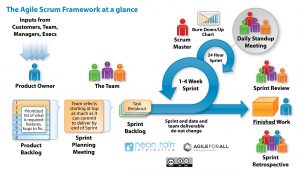Dale’s Revised Definitions
Introduction:
In this assignment we will define one term using three different strategies, a parenthetical definition, a sentence definition, and an expanded definition. This will show us the role definitions can play in different situations, and also give us insight into the different levels of detail appropriate for each of those situations.
Reading situation:
A software development team leader explaining a term to a new intern.
Parenthetical definition:
Don’t worry about talking in today’s standup (a daily task planning meeting), you don’t have any tasks yet so you can just listen and see how we do it.
Sentence definition:
A standup is a daily 10- to 15-minute meeting where each person in a development team talks about the tasks they completed the previous day, the tasks they plan on completing that day, and any hinderances they have come across that inhibit their ability to complete those tasks.

Figure 1 Diagram of the Agile Framework
Source: “Agile Scrum for Web Development.” Neon Rain Interactive, www.neonrain.com/agile-scrum-web-development.
Expanded definition:
A standup is a meeting type used in software development, which derives its name from the fact that participants generally stand up while conducting the meeting. Standup meetings are also known as scrum meetings and are a fundamental part of the Agile Development Methodology. Agile has become one of the most popular approaches to planning and delivering software since its development in the early 2000s, and as a result standup meetings are an important part of most developers’ daily life (Lynn).
A standup is basically a 10- to 15-minute meeting at the beginning of each workday, where product owners and developers have a strategic discussion to keep their team informed, connected, and aligned through the whole development process. As you can see in Figure 1, the Agile framework is comprised of one- to four-week work intervals, or “sprints,” where tasks are taken from a “backlog” and assigned to team members to complete during that sprint. The standup serves to keep everyone on track and informed during this process (“Agile Scrum for Web Development”).
While the specific structure of a standup meeting varies from team to team, all standups will have each team member answer three questions. Dan Radigan’s article “Standups for Agile Teams” outlines these questions. The first question is “What did I work on yesterday?” and serves to keep team members accountable for their progress and to share any victories or challenges they came across. The second question is “What am I working on today?”, which serves to get developers thinking about their tasks in manageable chunks and offers other team members the opportunity to provide input. The third question is “What issues are blocking me?” which allows team members to raise any concerns from their previous day and also let others know if one of their tasks is being held up by another person’s work (Radigan).
References:
“Agile Scrum for Web Development.” Neon Rain Interactive, www.neonrain.com/agile-scrum-web-development. Accessed June 8 2022.
Lynn, Rachaelle. “The History of Agile.” Planview, www.planview.com/resources/guide/agile-methodologies-a-beginners-guide/history-of-agile. Accessed June 8 2022.
Radigan, Dan. “Stand-ups for agile teams.” Atlassian Agile Coach, www.atlassian.com/agile/scrum/standups. Accessed June 8 2022.
Leave a Reply